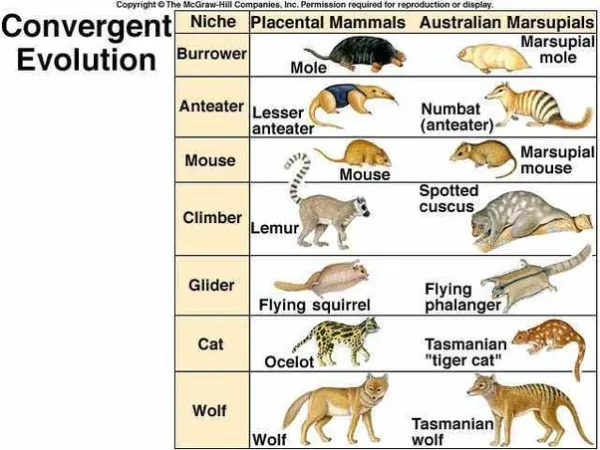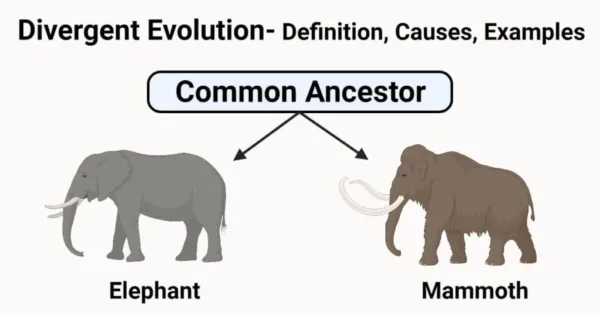In the world of evolution, there are two interesting things happening: Convergent Evolution and Divergent Evolution. They help make life very diverse. Convergent Evolution is like a cool trick – it makes different animals come up with the same answers to problems, even if they’re not closely related. On the other hand, Divergent Evolution tells us about similar animals that take different roads and become very different from each other. This makes them unique in how they adapt and survive.
What is Convergent evolution?
Convergent evolution is a biological phenomenon where unrelated or distantly related species independently develop similar traits or features in response to similar environmental challenges or selective pressures. In other words, different species, which do not share a common evolutionary ancestor for these traits, end up evolving similar characteristics due to the demands of their shared habitat or lifestyle.

Analogous Traits Arising from Similar Adaptations
This process results in the creation of analogous structures or traits that serve similar functions, despite the absence of a shared genetic lineage. These analogous structures are a product of the organisms adapting to similar ecological niches, even though their genetic backgrounds are different. Convergent evolution provides insights into the remarkable flexibility and adaptability of life forms, showcasing how different species can arrive at similar solutions through the lens of natural selection.
In simpler terms, convergent evolution is like nature’s way of finding the same solution to a problem multiple times, even though the species solving it are not closely related. It’s as if different animals, facing similar challenges, come up with similar tools to thrive in their environment.
Examples of Convergent Evolution
Convergent evolution happens when different animals and plants develop similar traits because they face similar challenges. Let’s look at a few examples:
Flying Experts: Birds, Bats, and Insects
- Birds, bats, and insects each learned to fly in their own special way.
- Even though they come from different groups, they all developed wings for flying.
- Birds have wings from their arms, bats have wings from their fingers and skin, and insects have wings made of a strong material.
- This shows how life forms can adapt to fly, no matter where they started.
Amazing Eyes: Vertebrates, Cephalopods, and Arthropods
- Fish, squids, and insects each have their own way to see the world around them.
- Even though they evolved on their own, their eyes work in similar ways.
- Fish have camera-like eyes, insects have many tiny eyes, and squids have special eyes for the deep ocean.
- This tells us that different creatures found different ways to see and explore.
Plant Armor: Prickles, Thorns, and Spines
- Plants also join in! They’ve created prickles, thorns, and spines to protect themselves from animals that want to eat them.
- These are like plant shields that keep grazers away and help them stay safe.
- Different plants used similar tricks to defend themselves and survive.
Crafty Impersonators: Mimicry for Safety
- Some creatures, like the harmless sand lizard, pretend to be tough animals to stay safe from predators.
- This trick, called mimicry, helps them avoid being eaten by looking like dangerous animals.
- For example, the sand lizard looks like a strong ground beetle to protect itself.
Divergent Evolution: Distinct Paths from a Common Origin
What is Divergent Evolution?
Divergent evolution is another fascinating concept in biology, showcasing how closely related species can evolve over time to become distinct and different from each other. Unlike convergent evolution, where unrelated species develop similar traits, divergent evolution focuses on species that share a common ancestor but gradually diverge into new forms due to varying environments or lifestyles.
This process leads to the emergence of diverse structures, functions, or traits in species that were once very similar. As they adapt to different circumstances, they accumulate differences in their genetic makeup and physical characteristics.
In simpler terms, divergent evolution is like a family tree where branches grow apart, and once-similar relatives become more and more different as they adapt to their own unique situations.

Examples of Divergent Evolution
Divergent evolution becomes clear when we examine various species that started from a common point but took different paths over time. Here are a few examples:
Fin Transformations: Dolphins and Fish
- Dolphins and fish may seem similar because they both live in water, but they’ve evolved differently.
- Dolphins belong to a group of mammals, and their fins resemble arms adapted for swimming.
- Fish, on the other hand, have fins that are optimized for gliding through water, reflecting their fishy lineage.
- This shows how similar body parts can change over generations for different ways of life.
Plant Diversity: Cacti and Trees
- Even plants show divergent evolution. Take cacti and trees, for example.
- Both started as simpler plants, but cacti adapted to dry deserts with water-storing abilities and spines for protection.
- Trees, on the other hand, embraced a tall structure and broad leaves to capture sunlight in forests.
- This demonstrates how plants with the same origins can take separate paths to survive in different environments.
Primate Variation: Lemurs and Monkeys
- Among primates, like lemurs and monkeys, divergent evolution is evident.
- Lemurs adapted to island life, developing unique traits such as large eyes for night vision and long tails for balance.
- Monkeys, living in various habitats, evolved grasping hands and complex social behaviors.
- This showcases how different lifestyles lead to significant changes in closely related species.
Bird Beaks: Finches and Parrots
- Bird beaks come in all shapes and sizes due to divergent evolution.
- Finches in the Galápagos Islands adapted their beak shapes to fit different food sources, such as seeds or insects.
- Parrots, on the other hand, developed strong beaks for cracking nuts and a tongue specialized for manipulating food.
- This illustrates how minor differences in the same structure can lead to diverse functions.
Differences between Convergent and Divergent evolution
| Aspect | Convergent Evolution | Divergent Evolution |
| Definition | Unrelated species evolve similar formations | Species with a common ancestor evolve to become different |
| Environment | Both species inhabit the same environment | Result in species inhabiting different environments |
| Evolution Result | Unrelated species with similar traits | Many different species, leading to speciation |
| Type of Structure | Analogous structures | Homologous structures |
| Causative Factors | Adaptation to similar environmental conditions | Migration, environmental fluctuations |
| Also Referred to As | Convergence | Divergent selection |
| Example | Wings of birds, insects, bats; Rheas, Ostriches, Emus | Darwin’s finches, Dinosaurs |
| Common Ancestry | Lack of recent common ancestor | Shared common ancestor |
| Similarity in Traits | Phenotypic similarity due to ecological niche | Increasing divergence in traits over time |
| Functional Similarity | Analogous structures (similar functions) | Homologous structures (common origin) |
Additionally, here are a few more differences between convergent and divergent evolution:

Common Ancestor:
- Convergent Evolution: Species lack a recent common ancestor.
- Divergent Evolution: Species share a common ancestor.
Similarity of Traits:
- Convergent Evolution: Unrelated species develop similar traits due to adapting to similar environments.
- Divergent Evolution: Species with a common ancestor develop different traits over time.
Structures:
- Convergent Evolution: Leads to analogous structures (similar functions, different origins).
- Divergent Evolution: Leads to homologous structures (common origin, different functions).
Environmental Factors:
- Convergent Evolution: Driven by similar environmental pressures and adaptations.
- Divergent Evolution: May be driven by migration, changing environments, and divergent selection.
Species Diversity:
- Convergent Evolution: Does not result in speciation; species remain distinct.
- Divergent Evolution: Can lead to speciation and the formation of multiple distinct species.
Time Scale:
- Convergent Evolution: Can occur over a relatively short time.
- Divergent Evolution: Typically occurs over longer periods of time.
Adaptive Radiation:
- Convergent Evolution: Does not usually involve adaptive radiation.
- Divergent Evolution: Can lead to adaptive radiation, resulting in diverse species from a common ancestor.
Genetic Relatedness:
- Convergent Evolution: Species are genetically unrelated.
- Divergent Evolution: Species are genetically related due to common ancestry.
Evolutionary Pathways:
- Convergent Evolution: Different pathways lead to similar traits.
- Divergent Evolution: Common pathways diverge to create distinct traits.
Examples:
- Convergent Evolution: Bird wings and bat wings, similar body forms in unrelated species.
- Divergent Evolution: Darwin’s finches, where different beak shapes evolved based on food sources.
Both convergent and divergent evolution are essential concepts in understanding how biodiversity arises and how species adapt to their environments over time.
Learn more